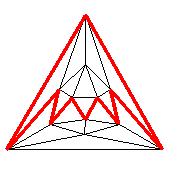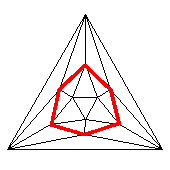| polygon | summary of route |
minimum edges/vertex for this to be meaningful |
symbol used in these pages |
|---|---|---|---|
| Vertex | V | ||
| Edge | E | ||
| Face | L, | F | |
| Petrie polygon | L,R, | 3 | P |
| Hole | L2, | 4 | H |
| 2nd-order Petrie polygon | L2,R2, | 5 | P2 |
| 3rd-order hole | L3, | 6 | H3 |
| 3rd-order Petrie polygon | L3,R3, | 7 | P3 |
| 4th order Hole | L4, | 8 | H4 |
| 4th-order Petrie polygon | L4,R4, | 9 | P4 |
| etc. | |||



